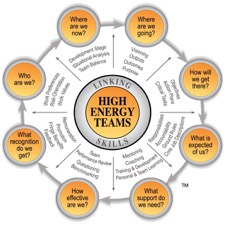Insights
High-Energy Teams model for intact team development
- 20 March 2012
Are you part of a high performing team?
Would you know how to become one? If you answered yes you’re probably in the minority. While many people (and the literature) espouse the importance of a high performing team, nobody really tells you how to get there.
When looking for a model to use for our own team development, we kept coming back to the Team Management Systems' (TMS) High-Energy Teams Model which our accredited practitioners have used with our clients over a long period of time with great success.
The TMS High-Energy Teams Model is based on the premise that teams perform when eight fundamental questions are addressed (see below). It is clear, simple and works. It demystifies the journey to becoming a high performing team while providing a pragmatic roadmap for getting there.

The eight questions are:
- Who are we? Understanding what makes each team member tick so that individual differences can be harnessed to achieve maximum performance
- Where are we now? A snapshot of the teams strengths, weaknesses, opportunities and threats and how this relates to the overall team balance
- Where are we going? Getting clear about the vision and goals for the team aligned to your organisations mission and goals taking into account where are we now as the base point
- How will we get there? Systematically developing a roadmap from where you are now to where you are going complete with objectives, action plans and measures to track progress
- What is expected of us? Understanding your job description, role,
responsibilities and accountabilities, as well as developing behavioural ground rules based on shared team values - What support do we need? Determining the support required to deliver results based on responses to the first five questions
- How effective are we? Regularly reviewing and improving performance
- What recognition do we get? Providing adequate recognition for performance in the form of feedback, remuneration, fringe benefits or promotion·
Linking skills The skills required to integrate and coordinate processes to support the eight questions above.
As we’ve discovered, using these questions as a basis for our own development has been instrumental in accelerating our own teams performance. We’ve taken the approach of carving out chunks of time regularly to address these questions with the whole team. The process has been insightful and everyone has commented on the value they’re getting from it.
The High Energy Teams model is the intellectual propoerty of TMS and is provided under license by accredited practitioners.

